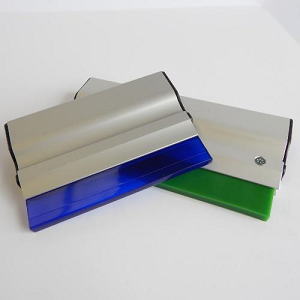Your squeegee can have a big impact on your printing – make sure you’re using the right one for the job!

Shape
The tip of the squeegee blade comes in several shapes:
Square – or straight-edge – squeegee blades are cut flat across the bottom. These are the most common types of squeegee blades and are used for more general screen printing job.
Beveled squeegees feature an
angle on one or both sides of the blade. Beveled blades are most often used
when printing on substrates that are curved or uneven.
Rigidity
Squeegee ridigity is measured by durometer,
and the higher the durometer, the harder the blade. Harder squeegee blades
sheer the ink more completely, while softer squeegees leave behind a heavier
ink deposit.
Squeegees in the 50 to 60
durometer range are considered soft squeegees. They’re used to leave
heavy ink deposits when printing on heavy substrates, controlling fibrillation
or printing with specialty inks.
The most commonly used squeegees are 70
durometer. These squeegees are considered to have a medium hardness
and are used for most general screen printing jobs..
Hard or ultra-hard squeegees, ranging from 80 to 90 durometer, are used to leave a
lighter ink deposit. They are ideal when printing with high mesh count screens,
when printing fine detail or in printing four-color process jobs.
There also are composite squeegee blades that have layers of different durometers. The printing edge is a lower durometer that molds smoothly along the screen, and a higher durometer layer that offers strenght to prevent the squeegee from bending and losing its shape.
Materials
Squeegees can be made from natural rubber, neoprene or
polyurethane.
Squeegees traditionally were made from natural
rubber. Rubber blades are less expensive than other squeegees, but
they have fallen out of favor because they absorb solvents and break down
quickly.
Neoprene blades
are more expensive than rubber but cheaper than polyurethane blades. Neoprene
is a popular squeegee choice because they resist breakdown better than rubber
blades.
Polyurethane squeegee blades are the most expensive option, but they are also the most durable. Polyurethane blades are usually used for jobs that will take an extended period of time and printing with automatic or semiautomatic presses.